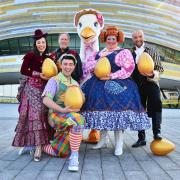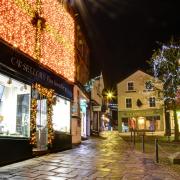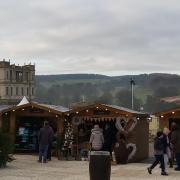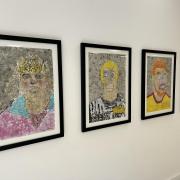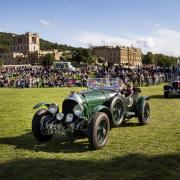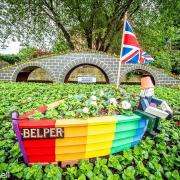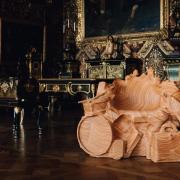Peter Seddon recounts how a former student of Derby School of Art created one of the world’s most iconic design classics

It is the sort of teaser that any self-respecting quiz team could debate with the most earnest vigour – and then still beg to differ. ‘What is the most widely reproduced single work of art in history?’ The ‘Mona Lisa’... Van Gogh’s ‘Sunflowers’... perhaps one of those surreal creations by Salvador Dali that adorned countless student bedrooms in the seventies... or for an ‘outside the box’ option maybe something on a Beatles album cover? In fact the generally accepted answer is rather more everyday – and in a manner of speaking we’ve all got it licked...
The classic design of the Queen’s head which was first used on British postage stamps in 1967 is said to have appeared to date on some 320 billion copies. It is undeniably an artwork – the bas relief sculpture by Arnold Machin (1911-1999) began its journey in embryo form 50 years ago in 1964. But Machin’s rare talent was nurtured much earlier – and the story has an intriguing Derbyshire flavour. For in the early 1930s the aspiring artist and sculptor began his serious training at Derby School of Art.
Arnold Machin was born on 30th September 1911 at Oak Hill in Stoke-on-Trent into a family of 12, the son of a ceramic modeller. He was apprenticed at 14 to Minton’s China Factory as a decorative painter, but was laid off following the Wall Street financial crisis of 1929. He continued his studies at Burslem School of Art, but on reaching his early twenties the need for regular employment led him to pastures new. After responding to a job advert in the Staffordshire Sentinel he left home for the first time, moving to Derby in 1933 to work as a painter at the Old Derby China Works on King Street. At the same time he enrolled for evening classes at Derby School of Art, attending every night of the week on a Ministry of Education course.
But his day job failed to endure. In 1935 the King Street works amalgamated with the more progressive Royal Crown Derby Porcelain Co. on Osmaston Road – as a result the 23-year-old Machin was again laid off. Yet this misfortune ultimately proved the stroke of fate on which Arnold’s artistic career was built. Recognising his talent, the Principal of Derby School of Art – Francis W. Hounsell (1885-1956) – persuaded Machin to enrol as a full-time student, and to facilitate his passage he was granted a scholarship. The course involved life-drawing, perspective, architecture and creative design – but it was sculpture and modelling that particularly interested Machin. To that end Hounsell created a sculpture module tailor-made to his mature student’s ambition – and Hounsell himself became Machin’s instructor.
This proved the key catalyst to Machin’s successful future – his Derby School of Art course normally took three years to complete, but Arnold passed his exams with distinction in only two. On the strength of his results he won a further valuable scholarship in 1937 to the Royal College of Art in London, graduating in 1940 with the Silver Medal, the top award at the RCA. During the war he returned to the Potteries to work for Wedgwood, but also served nine months of a one-year sentence in Wormwood Scrubs Prison as a conscientious objector. A character of firm conviction, he had resolved ‘never to fight’ and a spell working for the Voluntary Service for Peace in London led to his incarceration.
That controversial interlude apart, he progressed well, and his sculptural work in particular was increasingly critically acclaimed, especially large-scale pieces in his favoured medium of terra cotta. Machin exhibited at the Royal Academy from 1940, and when elected ARA in 1947 the Derby Telegraph lost no opportunity in recalling his local credentials: ‘As his first genuine patron, Derby has played an important part in shaping the richly promising career of Mr Arnold Machin.’
In 1949 he married fellow artist Patricia Newton of Coxbench, and settled initially in Stoke-on-Trent, with a retained studio in London. He was elected a full member of the Royal Academy in 1956, served as Master of Sculpture to the Royal Academy School from 1959 to 1966, received countless and varied commissions from influential clients, modelled high-profile pieces for both Wedgwood and Royal Worcester, and passed on his expertise through a number of key teaching and advisory roles. By 1965 his all-round reputation was such that he was awarded the OBE.
Again the Derby Telegraph reminded its readers that Derby School of Art had set Machin on his way – whilst conceding that the OBE was perhaps not unconnected to the ‘friends in high places’ which the sculptor had recently acquired. Indeed one of his recent ‘models’ was the reigning monarch – and the resulting portrayals of Queen Elizabeth II are Machin’s most enduring legacy.
His first significant capture of the Queen’s likeness was for coins rather than stamps. A ‘young head’ had been used since Queen Elizabeth II came to the throne in 1952. In 1964 in readiness for the planned decimalisation of 1968 it was decided to update the effigy – the Queen would after all soon be 40. Machin was one of several candidates selected to compete for creating the image – and after a painstaking process involving personal sittings at both Buckingham Palace and Balmoral his design was chosen for the new currency. The ‘Machin head’ was used for all British coins until 1984.
But prior to the decimal coinage being introduced, Machin had also been approached to consider stamp design. In 1965 the then Postmaster General, Anthony Wedgwood Benn – later celebrated Labour MP for Chesterfield – obtained the Queen’s permission to set another competition in motion, inviting five artists and sculptors to submit head designs for stamps. This despite Benn harbouring Republican views and privately lobbying for the monarch’s head to be removed altogether... from stamps at least!
Machin based his design on his coin likeness – and his assiduous attention to detail again paid off as he emerged the winner. After some 60 sketches and countless trial pieces and revisions he produced the bas relief plaque sculptured in clay – not unlike the applied relief designs on Wedgwood pottery – which was then photographed to appear on stamps. Based on the iconic Penny Black of Queen Victoria’s reign, his design was approved by The Queen herself with some personal modifications – and was first used officially on the 4d value issued in June 1967.
The design has been used on almost all British definitive stamps ever since. Known to philatelists as the ‘Machin series’, the ‘Definitives’ or simply ‘Machins’, the head created by the former Derby School of Art student has been printed an estimated 320 billion times... and still rising daily. On several occasions it has been suggested that an updated image ought to reflect The Queen’s advancing years, but so far this has been resisted, not least by the octogenarian herself, who has made it perfectly clear she is quite content to remain perpetually young. In 2007 Machin himself was given ‘the royal treatment’ – his photograph was used on a special set of commemorative stamps marking the 40 years since his design first appeared.
The story of the ‘Queen’s Head’ is a remarkable and romantic episode in the life of an artist and sculptor whose name is not generally known to the public at large despite his enduring legacy. One wonders what different course Machin’s life might have taken had he not been made redundant by the Derby China Works in 1935. Certainly he would not have become a full-time student at Derby School of Art, where his talent for sculpture and modelling was first seriously nurtured. That being the case, the Queen’s head as the world has come to recognise it may never have existed.
In addition to Machin’s most famous contribution to the visual arts, his much wider body of work has also been critically acclaimed and sits in important collections. From the 1940s onwards he embarked on an almost unbroken sequence of modelled portraits, figures, and groups, many of which were upon religious, allegorical or classical themes – in terra cotta, bronze and wood. The Victoria and Albert Museum and Tate Britain hold several key pieces. Machin’s modelled designs also embrace collectable pottery and porcelain – and he produced busts of Sir Winston Churchill, President Roosevelt, and again his ‘first lady’ The Queen.
Arnold Machin RA, OBE, died aged 87 on 9th March 1999, while living at his home of many years Garmelow Manor, Eccleshall, near Stafford. He was said to be a quiet man with strong beliefs, but one known and respected around the world for his talent as a sculptor and artist. He is not one of ‘Derbyshire’s own’ by birth – but the county can claim with no little pride to have helped him on his way.








